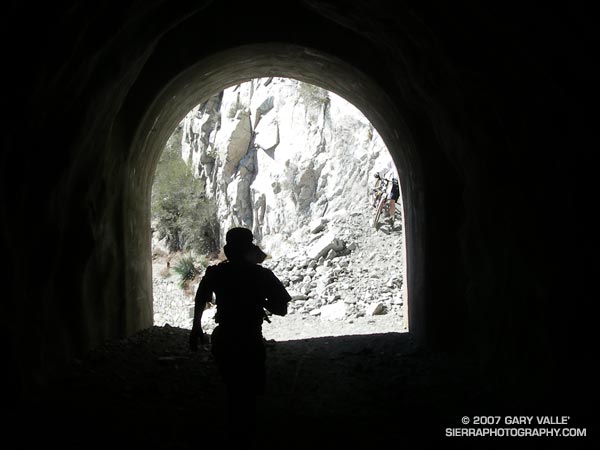
Runner in Mueller Tunnel, near Mt. Wilson, in the San Gabriel Mountains. From Sunday’s Strawberry – Bear Canyon Loop run.

Runner in Mueller Tunnel, near Mt. Wilson, in the San Gabriel Mountains. From Sunday’s Strawberry – Bear Canyon Loop run.
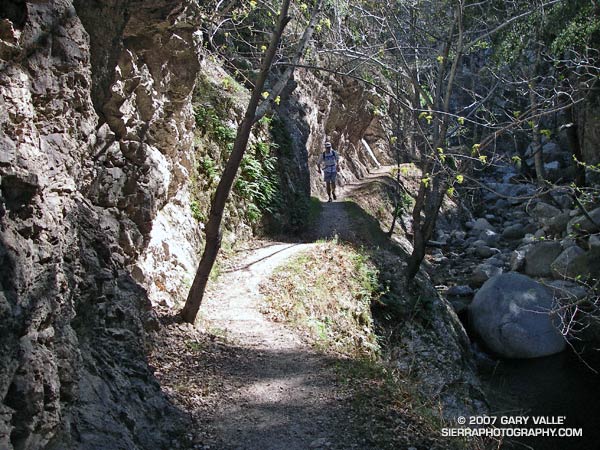
The Strawberry – Bear Canyon loop trail run is a longer, more adventurous variation of the run around Strawberry Peak described in the post Strawberry Peak Circuit.
The photograph Fall Leaves On Bear Creek was taken on this loop in November 2005. As described in that post, instead of descending directly to Switzer’s from Red Box, this route descends the West Fork to Valley Forge Campground and then climbs up and over the shoulder of Mt. Wilson, and down into Bear Canyon, eventually working its way back to Switzer’s and Clear Creek.
Without any wrong turns or other route finding issues the loop works out to about 25.5 miles with an elevation gain and loss of about 5500-6000 ft. The running (and hiking) is extremely varied, including fire roads, old road beds, easy trail, technical trail, and lots of up and down. Bear Creek’s lush canyon is gorgeous, but 20 miles into the run, it’s winding course and many creek crossings can prove demanding.
I attempted to obtain a GPS trace of this route in 2005, but the steep, narrow canyons defeated my Foretrex 201. Not so with my Forerunner 205. I continue to be amazed at the 205’s performance. Here’s a Google Earth image and Google Earth KMZ file of the GPS trace of my route.
Related posts: Spring Growth, Fall Leaves On Bear Creek, Forerunner 205.
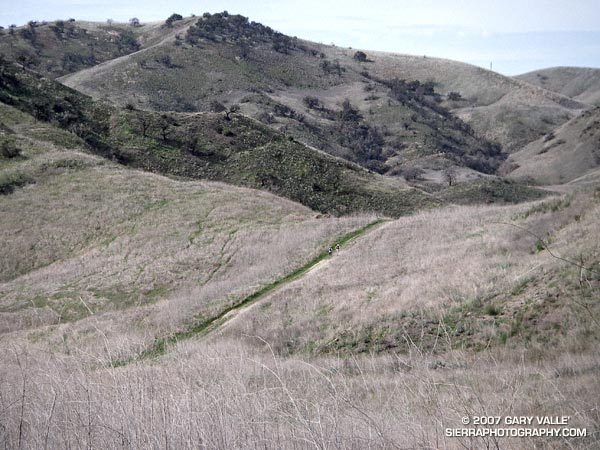
Two runners climb up the last yards of a hill before descending into Las Virgenes Canyon in Upper Las Virgenes Canyon Open Space Preserve.
The trail is a connector that joins East Las Virgenes Canyon with upper Las Virgenes Canyon. Our 15 mile loop started at the Victory trailhead, following the El Scorpion Trail to another long-used trail that climbs up to the ridge along the northern boundary of the preserve. From here we descended to Las Virgenes Canyon and worked over to Shepherd’s Flat and down Cheeseboro Canyon, eventually returning to the Victory trailhead by way of the main drag.
The area seen in the photograph is a small portion of the 24,000 acres that was burned in the Topanga Fire in late September 2005.
Although an undercoat of green is apparent, the drought in Southern California continues. According to NWS climate data, as of today, Downtown Los Angeles (USC) has recorded only 2.42 inches of rain since the water year began on July 1, 2006. This total is nearly 9 inches less than normal.
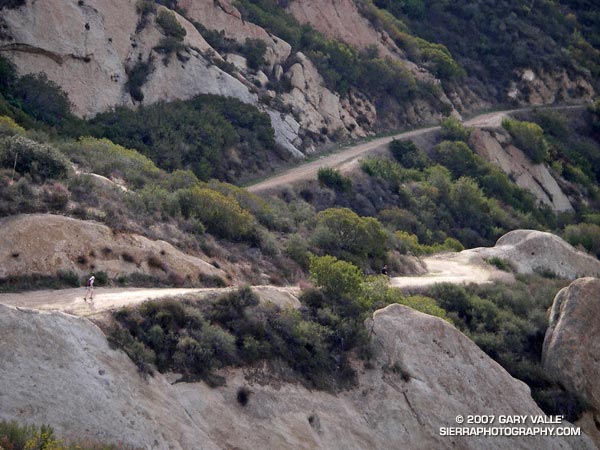
A friend cruises down Calabasas Peak Motorway on the way to the Stunt High Trail, Backbone Trail, Saddle Peak, and Tapia Park – a run of about 14 miles with an elevation gain of about 2600 ft., and loss of about 3600 ft.
Several excellent trail runs in the 11-15 mile range (or longer) can be done from the intersection of Malibu Canyon and Piuma Rd., near Tapia Park. These include an out and back to Saddle Peak (~13 mi), the Bulldog Loop (~14.5 mi), and point to point runs starting at the Secret Trail (~11 mi), or Tunnel #1 on Kanan Rd. (~12.5 mi).
Related posts: Saddle Peak, Rock Formations Along the Backbone Trail
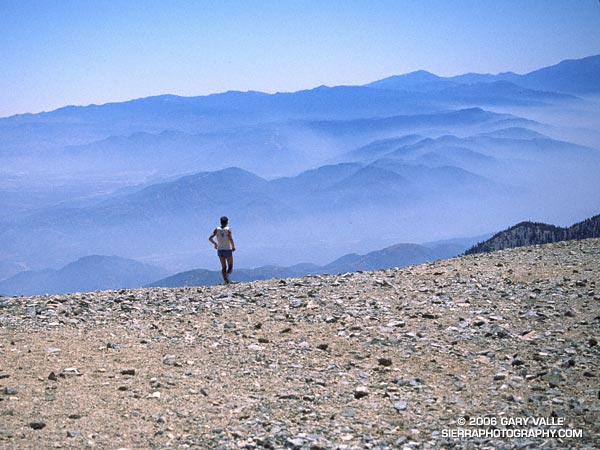
It’s mid-August, which means that Labor Day, and the Mt. Baldy Run to the Top, are only a couple of weeks away. There’s nothing quite like the experience of racing to the top of a 10,000 ft. peak en masse with 500+ other runners.
The nearly 8 mile course, with 4000′ of elevation gain, has been done in 1:00:49 by Matt Ebiner (1987), and in 1:15:32 by Carrie Garritson (1988). She was age 11 at the time! According to an article in the February / March 2002 Issue of TrailRunner Magazine “wild” Bill Lombardo has done the run barefoot!
More about the runner in this photo, the Mt. Baldy Run to the Top, and a race that climbs Mt. Baldy twice can be found in my SierraPhotography.com page Mt. Baldy, Runner Leaving the Summit. The photograph is from August 1991.
Related post: Mt. Baldy Run to the Top 2007
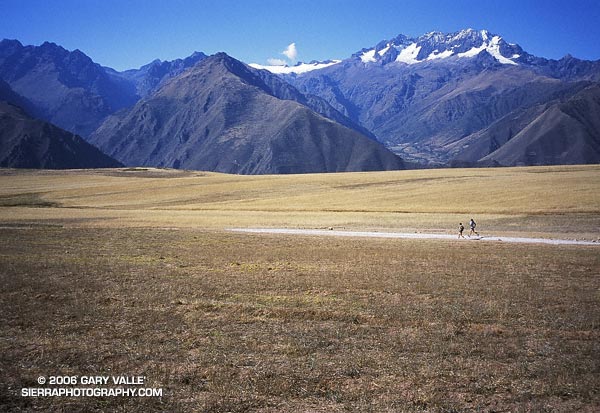
We did this acclimatization run early in our running adventure in Peru. The grain field is on a plateau at about 11,000′, and parallels the Sacred Valley of the Incas, and Urubamba River.
The run took us across the plateau, down to the Maras salt mines, and then down into the Sacred Valley at a little over 9000′. Excited about the trip, we ran most of the way back to the hotel in Yucay. That evening we enjoyed Pisco Sours and an excellent dinner, and then drifted off to sleep dreaming of big mountains and expansive views.
The high peaks beyond the valley are part of the Cordilla Urubamba and are over 5000m (16,400′). The highest point on the Inca Trail, the “pass of the dead woman,” is at about 13,800′. Later in the trip we would cross two 5000m passes while running a circuit of Mt. Ausangate.
The photograph is from July 15, 2003. The trip organizer, Devy Reinstein of Andes Adventures, is a accomplished runner, and a genius at travel logistics and organization.